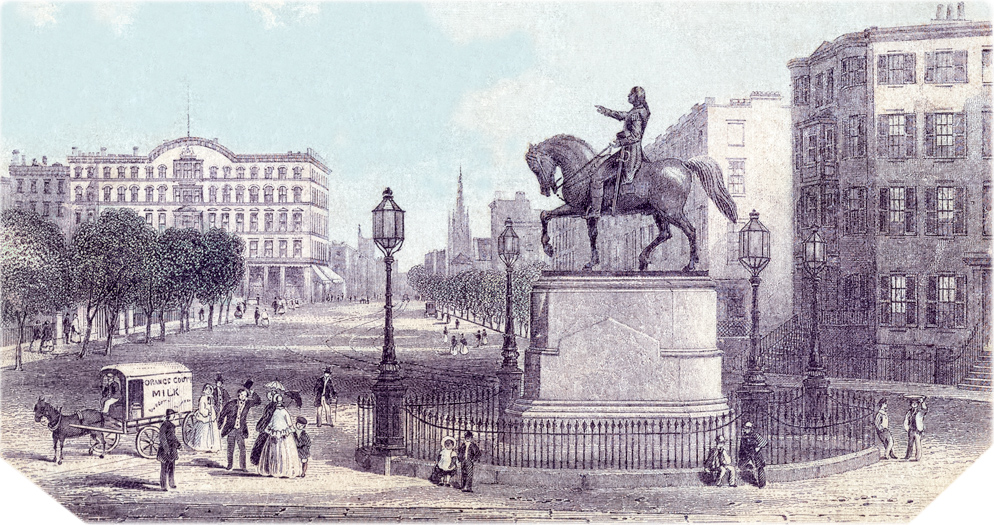
Union Square in the 19th Century
In the early 19th century the area which became Union Square was an intersection of roads, the Bloomingdale (later Broadway) and the Bowery (later Forth Avenue), with farms and old dwellings around. It was then known as "the Forks".
The "Union Place" was projected under the Commissioners’ Plan of 1811, originally extended from 1oth Street to 17th Street. In 1815, a committee appointed to consider proposals to reduce the size of some of the public squares recommended the discontinuance of Union Place. In April, 1831, an act was passed by the Legislature, in compliance with an appeal of the citizens, again creating a park out of the area contained between 14th and 15th Streets, Fourth Avenue, and the Bloomingdale Road. On November 7, 1831, a resolution adopted by the Board of Assistant Aldermen considered that the area was of too limited dimensions.
On April 5, 1832, the Legislature passed an act enlarging Union Place to its present size. On November 15, 1832, the New York Courier and Enquirer referred to the Union Place as Union Square. On November 14, 1832, the Harlem Rail Road was completed from Prince to 14th Street. On April 4 1833, the City acquired by condemnation proceedings the 3.483 acres comprising Union Square. The iron fence and other improvements were added in 1835 and 1836. It was made into a public park in 1839. In June, the same year, a line of cars of the Harlem Railroad started to run between the City Hall and Union Square.
The fountain was constructed in 1842 at the time of the completion of the Croton Aqueduct. It was tried on October 11 and first put in operation on October 14th, the day of the Croton Water Celebration.
By the 1820s, Manhattan Bank owned a good part of the lots in the area. These lots were put in the market about 1845. On February 26, the same year, the N.Y. Herald reported: "The growth of the city in the upper wards is astonishing. Whole streets of magnificent dwelling houses have been erected in the vicinity of Union Square within the last year, and some half dozen elegant churches are in process of erection in the same neighborhood". By 1849, the Union Park was completely surrounded by buildings and had become a beautiful residential section with private mansions.
The Church of the Puritans was built in 1846-1847, on 15th Street, at the corner of Broadway, designed by James Renwick, south of which was a collegiate institution for young ladies, maintained by the Reverend Gorham D. Abbott in the old Spingler Institute. The church was demolished in 1869 and replaced by Tiffany & Co. (1870).
Since the 1850s, it became home of many historical events. The 5-sory Everett House, on the corner of 4th Avenue (now Park Avenue South) opened in 1853. The George Washington Monument was dedicated in 1856. Other monuments were were installed later in the park, like the Abraham Lincoln (1870) and Marquis de Lafayette (1873).
On February 6, 1861, the Union League Club was founded to aid the Union cause. It leased the Parish residence at 26 East 17th Street and opened headquarters there on May 12.
The Union Square Theatre on 14th St. between Fourth Avenue and Broadway was opened in 1871. The iron fence was taken down, the same year, and the Park was redesigned in 1872 by the park was redesigned by landscape architects Frederick Law Olmsted and Calvert Vaux.
On October 25, 1881 the James Fountain was dedicated. It is an ornamental drinking fountain with a bronze statuary sculpted by Karl Adolph Dondorff. It is located on the west side of the park.
In 1892, the 11-story Jackson Building was completed on the north side of the Square. It was destroyed by fire in 1930 then it was cut down to its present height. The Decker Building, at 33 Union Square West, was built between 1892 and 1893 for the Decker Brothers, a piano manufacturer in New York City, founded in 1865 (it ceased operations around 1900).

Washington Monument in Union Square, looking north toward Forth Avenue. Everett House is on the left. Published in 1858 in the Nelson's Guide to the City of New York and its Neighbourhood.
Union Square in the 19th Century

|
Copyright © Geographic Guide - NYC in 19th Century. Historic Places. |